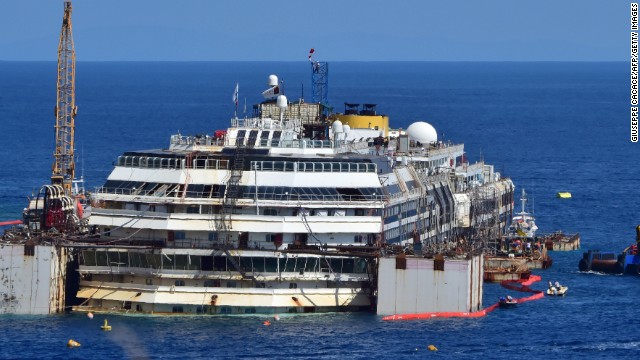Concordia cruise ship floats again
 Italian and American naval engineers today began refloating the giant Concordia cruise ship, freeing it from the reef on which it ran aground in April, 2012 in a partial shipwreck that took the lives of 32 passengers and crew. After closing waters around the island of Giglio where the Costa cruise line ship has lain for 27 months, and temporarily clearing air space over it, authorities gave the go ahead to engineers, who are using gigantic pneumatic pumps to lift the now lifeless carcass from its resting place. Last September, the engineers successfully righted the ship which had been lying on one side but decided to wait until the following summer when the sea would be calmer than in the winter to undertake the next step in the salvage operation. Furthermore, it was only recently decided where the ship would be towed for dismantling: several ports, in Italy and several other countries, including Turkey, were competing for the contract that is expected to create some 700 jobs.
Italian and American naval engineers today began refloating the giant Concordia cruise ship, freeing it from the reef on which it ran aground in April, 2012 in a partial shipwreck that took the lives of 32 passengers and crew. After closing waters around the island of Giglio where the Costa cruise line ship has lain for 27 months, and temporarily clearing air space over it, authorities gave the go ahead to engineers, who are using gigantic pneumatic pumps to lift the now lifeless carcass from its resting place. Last September, the engineers successfully righted the ship which had been lying on one side but decided to wait until the following summer when the sea would be calmer than in the winter to undertake the next step in the salvage operation. Furthermore, it was only recently decided where the ship would be towed for dismantling: several ports, in Italy and several other countries, including Turkey, were competing for the contract that is expected to create some 700 jobs.
But that does not mean nothing was being done over the last few months. During that time huge containers known as sponsons were attached to both sides of the ship’s hull. As compressed air is pumped into these boxes, the 16-deck ship should be raised off the reed and then moved sideways where, once stabilized, the same system will be used to raise it further, layer by layer. The total cost of the removal, originally set at $300 million has now grown to more than $1 billion.
At that point, the ship will be towed away by tugboats that will take it up north to the port of Genoa where it will be first stripped of anything moveable and then totally taken apart. But if all this seems likely to turn out to be an engineering and salvage success story. There are still several pressing concerns. One is what, if any, environmental damage has been caused by the presence of this monstrous floating hotel and whether shifting it is likely to cause any other damage, for example from the puring into the sea of any toxic materials or liquids imprisoned within the hull. The costs for repairing any environmental damage are supposed to be borne by the Costa cruise company.
Furthermore, it is well known that the body of one of the 32 casualties, that of an Indian waiter, was never recovered and Italian officials are unsure whether they will now be able to find his remains or whether they are gone forever. In the meantime, with the usually slow, snail-like pace of Italian justice, the trial of the ship’s captain, Francesco Schettino, goes on. He is facing 32 charges of manslaughter as well as accusations of causing the wreck and abandoning ship. So far one Costa official and sweveral crew members have pleaded guilty and received reduced sentences.


